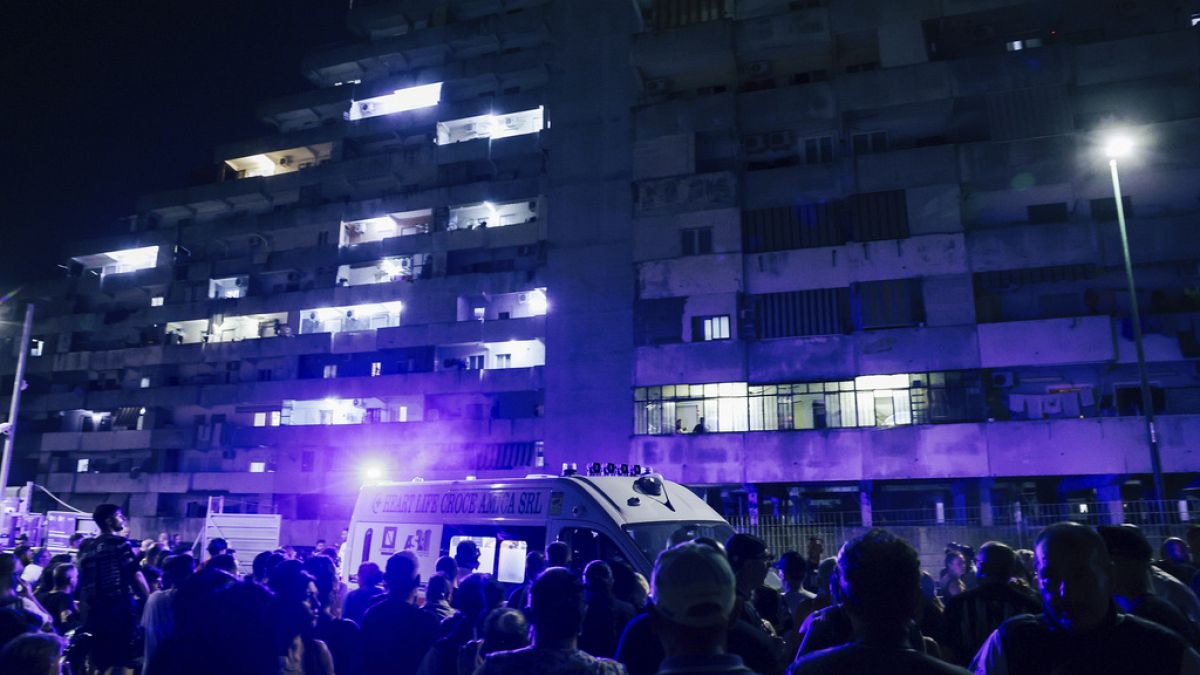North Dakota
SATURDAY ROUNDUP: No. 5 North Dakota downs No. 1 Minnesota, No. 2 Denver defeats No. 3 Boston College, UNH drops No. 4 Quinnipiac in OT, AIC bests No. 12 Penn State

North Dakota notched a pair of goals from its freshmen to collect a 2-1 victory over top-ranked Minnesota and salvage a series split on Saturday night from Ralph Engelstad Arena in Grand Forks, N.D.
After failing to crack the scoreboard last night, UND finally broke through early in the second period on a Jayden Perron deflection off a Garrett Pyke shot that found its way past goaltender Justen Close to give the Fighting Hawks a 1-0 lead less than six minutes into the stanza.
Then just 59 seconds into the third period, Jake Livanavage fired a puck from an awkward angle into the crease that found its way into the net to increase the advantage to 2-0 and give Livanavage his first career goal.
Liver with the winner!#UNDproud | #LGH pic.twitter.com/vpZowJJY0O
— North Dakota Hockey (@UNDmhockey) October 22, 2023
Minnesota clawed back into the contest with a deflection goal of its own by Jaxon Nelson at the 8:04 mark of the third, but UND did not let the Golden Gophers get any closer and closed out the 2-1 victory.
Ludvig Persson was strong between the pipes once again for the hosts, finishing with 21 saves on 22 shots.
Close made 32 saves for the Gophers.
USCHO.com Division I Men’s Poll – Oct. 16, 2023
No. 2 Denver 4, No. 3 Boston College 3
Denver scored three third-period goals to defeat Boston College 4-3 on Saturday night at Kelley Rink at Conte Forum in Chestnut Hill, Mass.
Carter King scored the game-winning goal with 2:02 remaining in regulation during a scramble in front of the goal, netting the Pioneers’ second power-play marker of the period. Tristan Broz tallied with the man advantage earlier in the frame.
KING HIM!
Pioneers take the lead. pic.twitter.com/e0SbCSDNb5
— Denver Hockey (@DU_Hockey) October 22, 2023
The Pioneers trailed 2-1 entering the final period but outscored the Eagles 3-1 in the period. Connor Caponi began DU’s run at 4:33 before BC briefly retook the lead on a Will Smith goal.
Massimo Rizzo also scored in the contest, evening the outing at 1-1 at 6:12 of the second frame. Jack Devine had two assists for his fourth consecutive multi-point game.
Denver goaltender Matt Davis made 24 saves in the victory.
Smith had two goals, Oskar Jellvik also scored, and netminder Jacob Fowler made 24 saves.
New Hampshire 5, No. 4 Quinnipiac 4 (OT)
Cy Leclerc’s second goal of the game at 3:51 of overtime gave the Wildcats a thrilling 5-4 win over Quinnipiac at the Whittemore Center in Durham, N.H.
Colton Huard, who also had two assists in the game, had tied the game 4-4 for UNH with a power-play goal at 3:01 of the third period.
WILDCATS WIN! Cy LeClerc nets the game-winner against No. 4 Quinnipiac! ‘Cats win 5-4!#BeTheRoar @HarvardPilgrim pic.twitter.com/nlxWXWrWfk
— UNH Men’s Hockey (@UNHMHOCKEY) October 22, 2023
Morgan Winters and Marty Lavins also scored and Robert Cronin and Ryan Conmy chipped in two assists each.
In goal, Tyler Muszelik made 35 saves for the win.
Vinny Duplessis and Matej Marinov combined to stop 26 shots for the Bobcats.
No. 6 Boston University 8, Notre Dame 2
Boston University scored five times in the first period en route to an 8-2 victory over Notre Dame on Saturday night at Compton Family Ice Arena in South Bend, Ind.
Eleven different Terriers recorded a point, with eight of those players tallying multiple points. Luke Tuch led BU with three points, all in the opening frame, as he scored a goal and assisted on two others. Shane Lachance scored the first two goals of his collegiate career while Macklin Celebrini also lit the lamp twice. Aiden Celebrini also scored his first goal as a Terrier and assisted on another.
lol this is just ridiculous from macklin.
💻: @peacock pic.twitter.com/bOrnAM4VAR
— BU Men’s Hockey (@TerrierHockey) October 21, 2023
Dylan Peterson recorded a goal and an assist, while Quinn Hutson lit the lamp, and Devin Kaplan, Sam Stevens and Jeremy Wilmer added two assists apiece.
BU goalie Mathieu Caron made 28 saves in the win.
Ryan Siedem and Tyler Carpenter scored for the Irish and Ryan Bischel and Jack Williams combined on a 42-save effort in goal.
No. 13 Ohio State 2, No. 7 Michigan 2 (Ohio State wins shootout)
Ohio State came from behind to tie Michigan 2-2 Saturday at Yost Ice Arena in Ann Arbor, Mich.
The Buckeyes opened the scoring in the first on a Patrick Guzzo goal and held the lead until two Wolverine power-play goals in the third from Gavin Brindley and TJ Hughes put UM ahead, but Ryan Gordon tied the game with just under five minutes remaining.
FINAL: OSU 2, UM 2 OT
Ohio State picks up the extra B1G point with a shootout win, 2-1 in 5 rounds!#GoBUcks pic.twitter.com/I1EH2DS7zG
— Ohio State Men’s Hockey (@OhioStateMHKY) October 22, 2023
Ohio State then won the shootout, 2-1 in five rounds, to pick up the extra point in the Big Ten standings.
Logan Terness made 42 stops for OSU, while Jake Barczewski finished with 35 saves for Michigan.
No. 9 Western Michigan 5, Bowling Green 2
Sam Colangelo’s hat trick lifted the Broncos over the Falcons 5-2 Saturday night at Lawson Arena in Kalamazoo, Mich.
Colangelo also contributed an assist for a four-point game.
Only 60 seconds into the game @WMUHockey takes the lead! 🚨
Costantini with his first as a Bronco
📺: https://t.co/ZyUdpPa7bb#NCHChockey // #BroncosReign pic.twitter.com/zNlOw30652
— The NCHC (@TheNCHC) October 21, 2023
Chad Hillebrand rang up four assists and Matteo Costantini added a goal and two helpers for the Broncos.
Ethan Phillips also scored for WMU and Cameron Rowe took the win in goal making 14 saves.
For Bowling Green, Spencer Kersten and Gustav Stjernberg scored goals. Cole Moore stopped 42 shots in a losing effort.
No. 10 Providence 4, RPI 2
Providence rallied to a win on Saturday at Schneider Arena, topping Rensselaer with a 4-2 final score on home ice in Providence, R.I.
The Friars crawled back after an early 2-0 deficit, paced by a pair of short-handed goals by senior captain Chase Yoder.
A GWG SHG for the captain 🫡 pic.twitter.com/qcMD4XOOgL
— PC Men’s Hockey (@FriarsHockey) October 22, 2023
Hudson Malinoski and Craig Neddham. also with an assist, added goals for the Friars.
Ryan Brushett and Danny Ciccarello scored for the Engineers.
Providence goalie Philip Svedebäck finished with 16 saves for the victory.
Carson Cherepak made 38 saves for RPI.
AIC 6, No. 12 Penn State 4
Penn State erased a three-goal deficit, but couldn’t complete the comeback as AIC scored two late goals to secure the 6-4 victory in non-conference action at Pegula Ice Arena on Saturday night in University Park, Pa.
Matt Rickard started the scoring for AIC just 2:54 into the game before Simon Mack tied it for Penn State at 6:30 of the opening frame.
The Yellow Jackets regained the lead late in the first period pushing it to 3-1 with a pair of goals less than three minutes apart from Julius Janhonen and Austen Long. AIC pushed the lead to 4-1 midway through the second period on a goal by Alexander Malinowski.
The Nittany Lions cut into the deficit as Chase McLane, Danny Dzhaniyev, and Reese Laubach scored to make it a 4-4 score late in the third period.
This is what Casey McDonald calling game looks like.@Buccigross @Atlantic_Hockey #AICommitted pic.twitter.com/p1wFTLjjAU
— AIC Hockey (@AIC_Hockey) October 22, 2023
The Yellow Jackets fought back and Casey McDonald delivered on an odd-man rush for the 5-4 edge at 17:47 and then an empty netter from Brian Kramer sealed the deal.
Alexandros Aslanidis made 36 saves in the victory for AIC.
Liam Souliere allowed four goals on 15 shots over the opening 32:55 before being lifted for sophomore Noah Grannan, who stopped seven of the eight shots he faced the rest of the way to take the loss.
Air Force 4, Alaska Anchorage 3 (OT)
The Falcons’ Austin Schwartz went coast to coast for the short-handed overtime game winner to beat Alaska Anchorage 4-3 Saturday night at the Avis Alaska Sports Complex in Anchorage, Alaska.
Air Force trailed 3-0 in the second period but came all the way back to force overtime by scoring on the power play, short-handed and even strength.
FALCONS WIN!!!! Austin Schwartz scores the short-handed game-winner with 2:47 left in OT. Falcons split the two-game series.
— Air Force Hockey (@AF_HKY) October 22, 2023
“We all just witnessed magic tonight,” Air Force coach Frank Serratore said. “Give Alaska Anchorage credit, they were clearly the better team for the first two periods. Thankfully for us, Guy Blessing was the best player on the ice. It is hard to turn a game around and we had absolutely nothing going when we were down 3-1 and killing a major, but we found a way to get it done. When Schwartz got his legs moving, their defenseman just couldn’t keep up. What great substance our guys scored to come all the way and get a split up here.”
Just 38 seconds into the game, the Seawolves scored as Porter Schachle set up Ben Almquist for a 1-0 lead.
UAA then scored two goals in less than four minutes for a 3-0 lead in the second as Almquist scored his second of the game and Maximillion Helgeson redirected a point shot by Gunnan Vandamme.
The Falcons got on the board late in the second period on the power play. Clayton Cosentino gained the zone and dropped the puck for Will Gavin, who slid the puck to the center point to Chris Hedden, who gave it back to Gavin in the right circle for a one-timer and Gavin’s second goal of the season.
Air Force’s penalty kill not only got the job done but scored a short-handed goal. Mason McCormick forced a turnover deep in the Seawolves end and scored from Chris Hedden at 1:40 of the third period to cut the deficit to 3-2. Air Force tied the game with 12:01 remaining on Luke Rowe’s first goal of the season. Lucas Coon, playing his first game in nearly a year after recovering from injuries, collected the assist by getting the puck to Hedden. Hedden set up Rowe for a one-timer from the top of the left circle to tie the game.
Blessing made 25 saves for the Falcons. Jared Whale made 18 for the Seawolves.

North Dakota
North Dakota judge will decide whether to throw out a challenge to the state's abortion ban
BISMARCK, N.D. (AP) — Attorneys argued Tuesday over whether a North Dakota judge should toss a lawsuit challenging the state’s abortion ban, with the state saying the plaintiffs’ case rests on hypotheticals, and the plaintiffs saying key issues remain to be resolved at a scheduled trial.
State District Judge Bruce Romanick said he will rule as quickly as he can, but he also asked the plaintiffs’ attorney what difference he would have at the court trial in August.
The Red River Women’s Clinic, which moved from Fargo to neighboring Moorhead, Minnesota, filed the lawsuit challenging the state’s now-repealed trigger ban soon after the fall of Roe v. Wade in 2022. The clinic was North Dakota’s sole abortion provider. In 2023, North Dakota’s Republican-controlled Legislature revised the state’s abortion laws amid the lawsuit. Soon afterward, the plaintiffs filed an amended complaint, joined by doctors in obstetrics, gynecology and maternal-fetal medicine.
North Dakota outlaws abortion as a felony crime, with exceptions to prevent the mother’s death or a “serious health risk” to her, and in cases of rape or incest up to six weeks of pregnancy.
The plaintiffs allege the law violates the state constitution because it is unconstitutionally vague for doctors as to the exceptions, and that its health exception is too narrow.
The state wants the complaint dismissed. Special Assistant Attorney General Dan Gaustad said the plaintiffs want the law declared unconstitutional based upon hypotheticals, that the clinic now in Minnesota lacks legal standing and that a trial won’t help the judge.
“You’re not going to get any more information than what you’ve got now. It’s a legal question,” Gaustad told the judge.
The plaintiffs want the trial to proceed.
Meetra Mehdizadeh, a staff attorney with the Center for Reproductive Rights, said the trial would resolve factual disputes regarding how the law would apply in various pregnancy complications, “the extent to which the ban chills the provision of standard-of-care medical treatment,” and a necessity for exceptions for mental health and pregnancies with a fatal fetal diagnosis.
When asked by the judge about the trial, she said hearing testimony live from experts, as compared to reading their depositions, would give him the opportunity to probe their credibility and ask his own questions to clarify issues.
In an interview, she said laws such as North Dakota’s are causing confusion and hindering doctors when patients arrive in emergency medical situations.
“Nationally, we are seeing physicians feeling like they have to delay, either to run more tests or to consult with legal teams or to wait for patients to get sicker, and so they know if the patient qualifies under the ban,” Mehdizadeh said.
In January, the judge denied the plaintiffs’ request to temporarily block part of the law so doctors could provide abortions in health-saving scenarios without the potential of prosecution.
A recent state report said abortions in North Dakota last year dropped to a nonreportable level, meaning there were fewer than six abortions performed in 2023. The state reported 840 abortions in 2021, the year before the U.S. Supreme Court’s ruling overturning Roe v. Wade.
The court’s decision enabled states to pass abortion bans by ending the nationwide right to abortion.
Most Republican-controlled states now have bans or restrictions in place. North Dakota is one of 14 enforcing a ban on abortion at all stages of pregnancy. Meanwhile, most Democratic-controlled states have adopted measures to protect abortion access.
The issue is a major one in this year’s elections: Abortion-related ballot measures will be before voters in at least six states. Since 2022, voters in all seven states where similar questions appeared have sided with abortion rights advocates.
___
Associated Press writer Geoff Mulvihill in Cherry Hill, New Jersey, contributed to this story.
North Dakota
Pressures could lead to more closures at ND nursing homes

BISMARCK — Federal requirements for nursing homes to have a registered nurse on duty 24 hours each day are expected to add pressure to an already challenging workforce situation for the 75 rural and urban facilities across the state.
A majority will have a hard time meeting the 24/7 requirement for RNs, according to the North Dakota Long Term Care Association.
Nikki Wegner, director of the NDLTCA, said most facilities across the state are currently well-staffed except for that RN requirement.
Cost pressures have already led to six facilities closing in the past 35 months, she said.
“We’ve never had that before in our history, and the majority of them were because of staffing issues,” Wegner said.
Urban facilities have until May 2026 to comply with the federal requirements, while those in rural areas have until May 2027.
Rules have also changed, with areas like Dickinson, Devils Lake, Jamestown, Valley City and Williston no longer considered rural, meaning they’ll need to meet requirements sooner.
“I worry about how many facilities might have to close because they can’t meet the standards,” said Reier Thompson, president and CEO of Missouri Slope in Bismarck, which has long-term care for over 250 residents.
“What’s that going to do to access to care, especially in the more rural area, where people are traveling 100 miles from their hometown to a nursing facility, and maybe a spouse is commuting that a couple times a week?” he said. “It’s going to be hard, especially in winter.”
Throughout the COVID-19 pandemic, staffing full-time nurses and nursing assistants at long-term care facilities became a huge challenge. Many turned to short-term contract nurses, and costs soared.
The situation has begun to turn around for Jill Foertsch, administrator at St. Gerard’s Community of Care in Hankinson. St. Gerard’s has added new certified nursing assistants while reducing the use of contract nurses from eight just a short time ago to two.
“We have improved significantly,” Foertsch said.
That being said, finding enough RNs to meet the new requirement is going to be tough.
“We are not able to meet the 24/7 staffing mandate,” she said.
The situation may mirror what happened during the pandemic, but contract RNs are in short supply and high priced, she said.
The one caveat is this time there’s no funding on the horizon.
“We will not be getting any help from the government like we did during COVID, and that’ll be what would most likely help us to shut down, because it’s just not sustainable that way,” Foertsch said.
The NDLTCA estimates contract nurses accounted for around $73 million of statewide nursing costs in 2023, up from around $24 million in 2020.
Staffing at nursing homes in the state is also now around 1,200 workers below what it was in early 2020 numbers, according to the NDLTCA.
The NDLTCA estimated that only 35% of urban facilities and only 14% of rural facilities would currently meet the future 24/7 RN staffing requirement.
Right now, most facilities rely on a mix of RNs, physician’s assistants, nurse practitioners or physicians through phone or telehealth if an RN isn’t on duty beyond the normal daytime shift. Finding RNs to fill overnight and other shifts is going to be difficult.
No funding is earmarked for those shortfalls, the numbers of RNs are just not available, and no pipeline is in the works to increase the availability of RNs.
“We’re still in a workforce crisis, we still rely on a lot of contract nurses, and it’s expensive, and then you add the mandate on there to increase even more,” Wegner said, adding that the state needs at least 80 if not more RNs to fulfill the mandates.
Several states have already met stringent requirements for waivers from the rule, but Wegner isn’t hopeful North Dakota will qualify.
Blake Kragnes, administrator at the 85-bed Knife River Care Center in Beulah, said his nursing home has been able to keep staffing at a good level, but the mandate of the 24/7 requirement for RNs is going to be tough to meet.
“When you look at the number of college grads graduating with a nursing and RN degree, it’s down, and that makes it complicated to meet a mandate that comes with no funding,” he said.
Kragnes is looking at how to increase recruitment and retention by connecting with area high schools to start people in a health care career that may lead them to full-time registered nursing status.
Foreign nurse visa freeze
One avenue most facilities are trying to use is immigration, but the U.S. State Department recently froze EB-3 visas used by foreign nurses for the rest of the fiscal year, leaving around 10,000 foreign nurses in limbo until resolved.
A cap of 40,000 visas for foreign nurses has been in place since 1990, and legislation to increase the cap stalled in the U.S. Congress after its introduction in November 2023.
According to the Migration Policy Institute, international nurses account for around 16% of the nursing workforce in the country.
National health care nonprofit KFF, formerly known as The Kaiser Family Foundation, estimates that 1 in 6 of the 3.2 million RNs in the U.S. is an immigrant nurse.
Amy Kreidt, administrator of St. Luke’s Home in Dickinson, which operates an 88-bed long-term care facility, echoed Foertch’s comments by saying the mandate coupled with the high cost of contract nursing could put more rural nursing homes out of business.
“Right now we’re not (in danger of closing), but if we can’t start getting nurses here, we have to keep that as an option and review,” she said.
St. Luke’s has had success with its foreign nurses, but the visa freezes and annual caps, along with the complicated immigration process, have led to it taking up to four years to get foreign nurses, Kreidt said.
“And that’s if it goes through relatively quickly, and it seems to always have taken that long, but now, with additional delays, it will continue to take that long and longer,” she said. “The contact is only three years long and it takes over four years to get them, so the numbers don’t add up.”
LeAnn Hokanson, vice president of resident services at Missouri Slope, said besides funding to cover nursing costs, there is a major need for both immigration and on expanding nursing programs.
“The (foreign nurses) that we’ve been interviewing most recently, they’ve been waiting and waiting and waiting,” she said. “Some of them wait for 10 years to get their call to have a facility interview them. It’s all stuck in that visa process.”
Contributed / Missouri Slope
Kreidt has previously tapped into the nursing program at Dickinson State University, but with its entire full-time nursing faculty resigning on July 10, the future of that program is uncertain.
The situation also adds further uncertainty regarding the nursing pipeline for health care facilities across the state and region.
North Dakota’s new Office of Legal Immigration is looking to pilot a cap-exempt H-1B visa program in the next several months specifically for foreign nurses, according to a study it released in late May.
This could help increase the numbers of RNs and nurse practitioners, though hurdles exist since the H-1B immigration process is more costly and facilities need to meet eligibility requirements.
This story was originally published on NewsCoopND.org
______________________________________________________
This story was written by one of our partner news agencies. Forum Communications Company uses content from agencies such as Reuters, Kaiser Health News, Tribune News Service and others to provide a wider range of news to our readers. Learn more about the news services FCC uses here.
North Dakota
South Dakota Democratic delegates unanimously endorse Harris as presidential pick • South Dakota Searchlight

The South Dakota delegates to the Democratic National Convention met virtually Monday night and voted unanimously to endorse Vice President Kamala Harris as their nominee in the 2024 presidential race.
South Dakota Democrats hopeful, not yet ready to endorse Harris as presidential nominee
In voting to endorse Harris, South Dakota Democrats fell in line with other state and national Democratic leaders who quickly followed the lead from President Joe Biden, who dropped out of the 2024 race via social media Sunday afternoon and endorsed Harris as his successor shortly thereafter.
Democrats in Nebraska, Maryland, Florida, New Hampshire, Alabama, North Carolina and Virginia were among the states where Democrats backed Harris as of Monday evening.
Harris has also picked up endorsements from key leaders at the national level. California Gov. Gavin Newsom, mentioned as a possible Democratic contender himself, endorsed Harris quickly on Sunday. Former House Speaker Nancy Pelosi endorsed Harris Monday. Senate Majority Leader Chuck Schumer and House Minority Leader Hakeem Jeffries had not endorsed Harris as of Monday evening, but Jeffries said earlier in the day that Harris had “excited the House Democratic Caucus and she’s exciting the country.”
Late Monday evening, the New York Times, CNN and other national media organizations reported that Harris had secured the backing of more than the 1,976 delegates needed to win the nomination in the first round of voting at the Democratic National Convention in Chicago next month. The news came by way of a poll from The Associated Press, which broke the story.
The poll listed 2,668 delegates pledged to Harris and 54 undecided as of 10 p.m. CST Monday.
The Democratic National Committee will move forward with the process to formally nominate a presidential candidate Wednesday when its Rules Committee meets in a public virtual session amid ongoing efforts to set up a virtual roll call vote ahead of the convention next month in Chicago, according to reporting from States Newsroom.
South Dakota Democrats backed Biden with around 75% of the vote in the state’s June 4 primary. In a news release, the South Dakota Democratic Party announced that its 20 voting delegates to the August convention had voted unanimously to back Harris.
“We thank President Biden for his leadership throughout his career and for choosing Kamala Harris four years ago to be his Vice President,” said Delegate Chair Jessica Meyers. “Harris has proven that she is more than equipped to take on the Presidency and we as a delegation are looking forward to casting the official vote for her.”
GET THE MORNING HEADLINES DELIVERED TO YOUR INBOX
-

 Politics1 week ago
Politics1 week agoTwo key states to see massive GOP voter registration operation
-

 News1 week ago
News1 week agoShooting at a Trump Rally in Pennsylvania: Maps and Photos
-

 World6 days ago
World6 days agoOne dead after car crashes into restaurant in Paris
-

 News5 days ago
News5 days agoVideo: Young Republicans on Why Their Party Isn’t Reaching Gen Z (And What They Can Do About It)
-

 News7 days ago
News7 days agoIn Milwaukee, Black Voters Struggle to Find a Home With Either Party
-

 News1 week ago
News1 week agoVideo: Biden Asks America to ‘Lower the Temperature’
-

 World1 week ago
World1 week agoUkraine: shelling in Kherson leaves at least two people dead
-

 World4 days ago
World4 days agoFreshers' week in Strasbourg for new EU lawmakers















